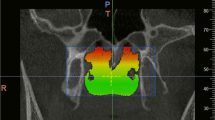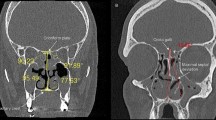Abstract
Purpose
The objective of this study was to prove the higher frequency of the type 6 deformations overall compared to the results obtained by conventional diagnostic methods, such as computed tomography images and clinical examination.
Methods
The study was performed at the Institute of Anatomy, where a total of 114 randomly selected skulls were examined. The skulls were then scanned in a fixed position using the cone-beam technique (CBCT). The literature epidemiological data of the clinical incidence of type 6 in studies that also used Mladina classification were obtained.
Results
There was a statistically significant difference (p < 0.0001) in the frequency of type 6 deformation as diagnosed by visual inspection (22.8%) and computed tomography (7.9%). The frequency obtained by CT imaging amounted 7.9% and was almost the same as the results obtained by a clinical examination which varied between 9 and 11%.
Conclusions
The frequency of type 6 nasal septal deformation is higher by visual inspection of the skulls than by computed tomography imaging at a level of significance of 0.05. The incidence of type 6 findings on coronal CT images of paranasal sinuses is approximately the same as that found with anterior rhinoscopy. Type 6, visible or concealed; probably have one-fourth to one-fifth people in population, so the number of clinically overlooked and/or unrecognized types 6 is much greater than we thought it to be.






Similar content being viewed by others
References
Enlow DH (1965) Growth and remodeling of the human maxilla. Am J Orthod 51:446–464
Mladina R (1985) REKAS (recurrent epistaxis from Kiesselbach’s area syndrome). Chir Maxillofac Plast 15:91–95
Mladina R, Čavčić J, Šubarić M (2002) Recurrent epistaxis from Kiesselbach’s area syndrome in patients suffering from hemorrhoids: fact or fiction. Arch Med Res 33:1–2
Mladina R, Skitarelić N, Poje G, Šubarić M (2015) Clinical implications of nasal septal deformities. Balkan Med J 32:137–146
Carić T, Mladina R, Cingi C et al (2016) Could nasal septal deformities type 5 and 6 be a predictive factor of the individual genetic predilection for the onset of an acute coronary syndrome? B-ENT 12:227–233
Verwoerd CDA, Mladina R, Nolst Trenite GJ, Pigott RW (1995) The nose in children with unilateral cleft lip and palate. Int J Pediatr Otorhinolaryngol 32(Suppl):45–52
Mladina R, Ostojić D, Koželj V, Heinzel B, Lj B (1997) Pathological septal deformities in cleft palate children. L’Otorinolaryngol Pediatr 2–3:75–80
Mladina R, Šubarić M (2003) Are some septal deformities inherited type 6 revisited. Int J Ped Otorhinolaryngol 67:1291–1294
Mladina R, Čujić E, Šubarić M, Vuković K (2008) Nasal septal deformities in ear, nose and throat patients: an international study. Am J Otolaryngol 29:75
Hewaidi G, Omami G (2008) Anatomic variation of sphenoid sinus and related structures in Libyan population: CT scan study. Libyan J Med 3:128. https://doi.org/10.4176/080307
Yildirim I, Okur E (2003) The prevalence of nasal septal deviation in children from Kahramanas, Turkey. Int J Pediatr Otorhinolaryngol 67:1203–1206
Teul I, Zbislawski W, Baran S, Czerwinski F (2009) Deformation of the nasal septum in children, adolescents, and adults in Western Pomerania province of Poland. Eur J Med Res 14(Suppl 4):244–247
Wee JH, Kim DW, Lee JE et al (2012) Classification and prevalence of nasal septal deformity in Koreans according to two classification systems. Acta Otolaryngol 132:52–57
Aljibori AS, Hassan AD, Alwan AM (2010) Assessment of nasal septal deformities by anterior rhinoscopy and nasal endoscopy. Tikrit Med J 16:14–22
Šubarić M, Mladina R (2002) Nasal septum deformities in children and adolescents: a cross sectional study of children from Zagreb, Croatia. Int J Pediatr Otorhinolaryngol 63:41–47
Song SY, Kim IT, Chang KH, Lee KS, Kim HJ, Lim HJ (1999) The prevalence of nasal septal deformities among children in kindergarten and first grade in Anyang and Kunpo cities. J Rhinol 6:58–60
Rao JJ, Vinay Kumar EC, Ram Babu K et al (2005) Classification of nasal septal deviations-relation to sinonasal pathology. Indian J Otolaryngol Head Neck Surg 57:199–201
Min YG, Jung HW, Kim CS (1995) Prevalence study of nasal septal deformities in Korea: results of a nation-wide survey. Rhinology 33:61–65
Zielnik-Jurkiewicz B, Olszewska-Sosinska O (2006) The nasal septum deformities in children and adolescents from Warsaw, Poland. Int J Pediatr Otorhinolaryngol 70:731–736
Neves Pinto RM, Saraiva MS (1993) On the incidence of septal deformities according to Mladina classification and some correlated aspects. Folia Med 106:73–77
Daghistani KJ (2002) Nasal septal deviation in Saudi patients: a hospital based study. J KAU Med Sci 10:39–46
Chmielik M, Brożek-Mądry E, Chmielik LP (2006) Influence of the type of septum deviation on some parameters in the upper airways. New Med 3:71–73
Author information
Authors and Affiliations
Corresponding author
Ethics declarations
Conflict of interest
The authors declare that they have no conflict of interest.
Ethical approval
The study was performed at the Institute of Anatomy in full compliance with the principles of the Declaration of Helsinki. Since those skull samples already had all necessary permissions, because they belonged to the Institute, there was no need for additional approvements.
Additional information
Publisher's Note
Springer Nature remains neutral with regard to jurisdictional claims in published maps and institutional affiliations.
Rights and permissions
About this article
Cite this article
Arsov, B., Antunovic, R., Kovac Bilic, L. et al. Morphological, anatomical, radiological and clinical features of Mladina type 6 nasal septum deformations in humans. Eur Arch Otorhinolaryngol 277, 3375–3380 (2020). https://doi.org/10.1007/s00405-020-06215-0
Received:
Accepted:
Published:
Issue Date:
DOI: https://doi.org/10.1007/s00405-020-06215-0




